Analysis on the Difference of Reconstructed Soil Moisture Content in a Grassland Open-Pit Mining Area of China
Abstract
:1. Introduction
2. Overview of the Study Area
3. Materials and Methods
3.1. Sample Collection and Processing
3.2. Data Determination
3.3. Data Analysis
4. Results
4.1. Differences in the Soil Moisture Content under Different Soil Reconstruction Ways
4.2. Differences in the Soil Moisture Content under Different Vegetation Growth Grades
4.3. Differences in the Soil Moisture Content under Different Tillage Number
5. Discussion
5.1. Analysis of the Effect of Different Reconstructions on Soil Moisture Content
5.2. Analysis of the Effect of Different Tillage Methods and Vegetation Growth Grades on Soil Moisture Content
5.3. Limitation Analysis of Reconstructed Soil Material Ratios
6. Conclusions
- (1)
- Among the different soil reconstructions, soil moisture content was higher when soil reconstructions were rock and soil stripping material: coal gangue: fly ash = 3:4:3.
- (2)
- The soil moisture content of un-reclaimed land was mostly at a high level when the soil reconstruction method was rock and soil stripping material; and the soil moisture content was not at the highest level when the vegetation growth grade was higher. This indicates that it was not the case that the better the vegetation growth condition was, the higher the soil moisture content was.
- (3)
- In the case where the soil reconstruction method was rock and soil stripping material: coal gangue = 2:3, the soil moisture content of the reclaimed land decreased with the reduction of tillage frequency when the vegetation growth condition was optimal (vegetation growth grade was 4). In the case where the soil reconstruction method was rock and soil stripping material: coal gangue: fly ash = 3:4:3, when the vegetation growth condition was better (vegetation growth grade was 3 and 4), the soil moisture content of the reclaimed land was highest when it was tilled once every 15 days. It was also found in combination with other soil reconstruction methods that it was not always the case that the higher the frequency of tillage, the higher the soil moisture content.
Author Contributions
Funding
Institutional Review Board Statement
Informed Consent Statement
Data Availability Statement
Acknowledgments
Conflicts of Interest
References
- Liang, S.D. The word coal market features of 2018 and development tendency of 2019. China Coal 2019, 45, 118–129. [Google Scholar]
- BP. BP World Energy Statistics Yearbook (2020 Edition). In Global Energy Profiles; Coal Chemical Industry; BP: London, UK, 2020; Volume 48, p. 86. [Google Scholar]
- Rong, Y.; Hu, Z.Q.; Du, Y.X.; Yang, K.; Zhao, K.S. Research advance of soil amelioration materials in opencast mines. Met. Mine 2019, 2, 164–171. [Google Scholar]
- Zheng, F.W.; Zhen, X.; Chen, C.X. Development status and trend of world open-pit coal mine. Chain Coal 2014, 40, 113–116. [Google Scholar]
- Bian, Z.F. Research on the recultivation and the ecological reconstruction in coal mining area in China. Resour. Ind. 2005, 2, 18–24. [Google Scholar]
- Cao, Y.G.; Dallimer, M.; Stringer, L.C.; Bai, Z.K.; Siu, Y.L. Land expropriation compensation among multiple stakeholders in a mining area: Explaining “skeleton house” compensation. Land Use Policy 2018, 74, 97–110. [Google Scholar] [CrossRef]
- Cao, Y.G.; Bai, Z.K.; Sun, Q.; Zhou, W. Rural settlement changes in compound land use areas: Characteristics and reasons of changes in a mixed mining-rural-settlement area in Shanxi Province, China. Habitat Int. 2017, 61, 9–21. [Google Scholar] [CrossRef]
- Wang, X. Water Contention Variational Properties and Environmental Effects of Reconstructed Soil Filled with Coal Gangue. Master’s Thesis, Anhui University of Science & Technology, Huainan, China, 2014. [Google Scholar]
- Bai, Z.K.; Zhao, J.K.; Li, J.C.; Zhang, L.C. Soil Reconstruction and Soil Environmental Quality in Reclaimed Land of Large Open Pit Mine in Loess Area. In Proceedings of the 7th Symposium on Soil and Environment, Xiamen, China, 5–7 May 2021. [Google Scholar]
- Bell, L.C. Establishment of native ecosystems after mining—Australian experience across diverse biogeographic zones. Ecol. Eng. 2001, 17, 179–186. [Google Scholar] [CrossRef]
- Robson, T.; Golos, P.J.; Stevens, J.; Reid, N. Enhancing tailings revegetation using shallow cover systems in arid environments: Hydrogeochemical, nutritional, and ecophysiological constraints. Land Degrad. Dev. 2018, 29, 2785–2796. [Google Scholar] [CrossRef]
- Rekha, G.; Dipterdu, N.G. Biological reclamation of surface mined land without soil grafting: A working model. Int. J. Min. Reclam. Environ. 1993, 7, 167–170. [Google Scholar]
- Liu, X.R.; Hu, Z.Q.; Xu, T.; Zhu, Q. Summarizing research on topsoil substitute material of open-pit coal mine. China Min. Mag. 2017, 26, 81–85. [Google Scholar]
- Li, X.F. Law and Simulation of Moisture Transfer with Different Soil Reconstruction Model in Coal Mining Subside Area with High Ground-Water Level. Master’s Thesis, China University of Geosciences, Beijing, China, 2014. [Google Scholar]
- Hu, Z.Q.; Li, Y.; Li, J.M.; Mao, Y. Water characteristics of coal gangue hill and its influence on afforestation. Energy Environ. Prot. 1993, 4, 25–28. [Google Scholar]
- Hua, C.Y.; Zhou, G.Z.; Yin, X.; Wang, C.Z.; Chi, B.R.; Cao, Y.Y.; Wang, Y.; Zheng, Y.; Cheng, Z.R.; Li, R.Y. Assessment of heavy metal in coal gangue: Distribution, leaching characteristic and potential ecological risk. Environ. Sci. Pollut. Res. 2018, 25, 32321–32331. [Google Scholar] [CrossRef]
- Dang, Q.N.; Wang, J.X.; Yao, L.X.; Lv, G.L.; Zhang, R.Q. Spatial heterogeneity of soil water physical properties in coal gangue pile in arid desert area. Chin. J. Appl. Ecol. 2021, 32, 281–288. [Google Scholar]
- Zhang, R.; Zhang, C.L.; Li, M.S.; Zhang, H.J.; Cheng, J.H. Research on water dynamics of weathered coal gangue dumps. Bull. Soil Water Conserv. 2008, 1, 124–129. [Google Scholar]
- Wang, S.; Chen, M.; Chen, X.Y.; Chen, Q.H.; Liu, B.L.; Hu, Z.Y. Water redistribution and gas-heat diffusion of reconstruction soil filled with gangue. J. Soil Water Conserv. 2017, 31, 93–126. [Google Scholar]
- Liu, Y.; Gao, M.S.; Wu, W.; Tanveer, S.K.; Wen, X.X.; Liao, Y.C. The effects of conservation tillage practices on the soil water-holding capacity of a non-irrigated apple orchard in the Loess Plateau, China. Soil Tillage Res. 2013, 130, 7–12. [Google Scholar] [CrossRef]
- Sun, D.; Yang, H.; Guan, D.X.; Yang, M.; Wu, J.B.; Yuan, F.H.; Jin, C.J.; Wang, A.Z.; Zhang, Y.S. The effects of land use change on soil infiltration capacity in China: A meta-analysis. Sci. Total Environ. 2018, 626, 1394–1401. [Google Scholar] [CrossRef]
- Inoue, N.; Hamanaka, A.; Shimada, H.; Sasaoka, T.; Matsui, K. Fundamental Study on Application of Fly Ash as Topsoil Substitute for the Reclamation of Mined Land in Indonesian Open Cut Coal Mine; CRC Press: Beijing, China, 2014; pp. 535–540. [Google Scholar]
- Qiu, J.J.; Zheng, L.G.; Chen, X.Y.; Chen, Y.C. The effects of different fly ash incorporation on hydraulic characteristics and air permeability of coal gangue. Environ. Eng. 2021, 39, 131–186. [Google Scholar]
- Wu, C.W.; Xia, J.X.; Duan, Z.R. Review on detection methods of soil organic matter. SOM). Soils 2015, 47, 453–460. [Google Scholar]
- NY/T 1121.24-2012; Soil Testing Part 24: Determination of Total Soil Nitrogen by Automatic Nitrogen Determination Method. China Agricultural Press: Beijing, China, 2012.
- Yang, L.P.; Bai, Y.L.; Wang, L.; Wang, H.; Lu, Y.L. Study on the method of determining available phosphorus. Olsen-P. with high testing efficiency. Soils Fertil. Sci. China 2011, 3, 87–91. [Google Scholar]
- Zhang, F.N. Determination of fast-acting potassium in soils—Ammonium acetate leaching, flame photometric method. Soil Fertil. 1974, 1, 33–35. [Google Scholar]
- Wu, K.N.; Zhao, R. Soil texture classification and its application in China. Acta Pedol. Sin. 2019, 56, 227–241. [Google Scholar]
- Lima, M.T.; Ribeiro, A.I.; Dias, H.C.T.; Rosa, A.G.; Pires, G.T.; Tonello, K.C. The dynamics of the substrate recovery of waste dumps in calcary mining under natural regeneration. Cerne 2018, 24, 18–26. [Google Scholar] [CrossRef] [Green Version]
- Dang, H.Y.; Shao, M.A.; Chen, H.S.; Zhou, B.B. Effect of thickness and location of coal gangue on the process of water infiltration. J. Soil Water Conserv. 2012, 26, 62–66. [Google Scholar]
- Sequeira, C.H.; Wills, S.A.; Seybold, C.A.; West, L.T. Predicting soil bulk density for incomplete databases. Geoderma 2013, 213, 64–73. [Google Scholar] [CrossRef] [Green Version]
- Song, M.Z.; Lin, S.L.; Takahashi, F. Coal fly ash amendment to mitigate soil water evaporation in arid/semi-arid area: An approach using simple drying focusing on sieve size and temperature. Resour. Conserv. Recycl. 2020, 156, 104726. [Google Scholar] [CrossRef]
- Wang, Q.Y.; He, Y.X.; Chen, J.; Kong, H.Y.; Chai, R.S.; Zha, W.; Gao, H.J.; Ma, D.H.; Zhang, J.B. Effects of straw or fly ash addition on water holding capacity of typical Shajiang soil and drought stress tolerance in wheat. Trans. Chin. Soc. Agric. Eng. 2020, 36, 95–102. [Google Scholar]
- Ma, X.M.; Gao, E.M.; Yang, Q.H.; Wang, X.C.; Yao, X.G. Study on the relationship between ameliorated of Shajiang black soil applied by coal fly ash and maize growth. J. Henan Agric. Univ. 1998, 4, 2–6. [Google Scholar]
- Feng, Y.H.; Zou, Y.B.; Hu, R.Z.; Zhang, Y.Z.; Huang, Y.X. A study on physical and chemical properties of several fly ashes and their agrochemical behaviors of silicon and phosphorus. Sci. Agric. Sin. 2005, 2, 341–349. [Google Scholar]
- Wang, J.M.; Li, X.F.; Bai, Z.K.; Huang, L.B. The effects of coal gangue and fly ash on the hydraulic properties and water content distribution in reconstructed soil profiles of coal-mined land with a high groundwater table. Hydrol. Processes 2017, 31, 687–697. [Google Scholar] [CrossRef]
- Li, G.H.; Xu, H.; Shao, W.; Shen, J.F. Experimental study on improvement of physical properties of chestnut soil using fly ash in baotou. J. Soil Water Conserv. 2002, 6, 113–144. [Google Scholar]
- Zhang, S.W.; Ge, C.; Zhao, H.; Zheng, Y.; Shen, Q.; Zhou, Y. The distribution characteristics of soil physicochemical properties of fly ash reclaimed soils their response to covering soil thickness. J. Anhui Agric. Univ. 2019, 46, 43–50. [Google Scholar]
- Zheng, Y.M.; Quan, X.L.; Qiao, Y.M.; Li, X.L.; Shi, H.L. Physicochemical characteristics of open pit mining waste and its suitability for plant growth in high altitude area. J. Qinghai Univ. 2019, 37, 22–35. [Google Scholar]
- Correa CJ, P.; Nnadi, E.O.; Mbanaso, F.U.; Tonello, K.C. Urban gardens’ potential to improve stormwater management: A comparative analysis among urban soils in Sorocaba, Sao Paulo, Brazil. Sustainability 2022, 14, 2965. [Google Scholar] [CrossRef]
- Hu, H.Z.; Hu, B.Y.; Zhang, X.L.; Liu, Z.C.; Liu, J.Y.; Ci, E. Effects of no-tillage years and re-tillage times on soil bulk density and rice growth in paddy fields. Chinese Agric. Sci. Bull. 2020, 36, 1–7. [Google Scholar]
- Liu, B.; Wu, L.S.; Lu, J.W.; Li, X.K.; Su, W. Research Progress on the effects of different tillage methods on soil physical and chemical properties. Tillage Cultiv. 2010, 2, 55–65. [Google Scholar]
- Wang, X. The Effects of Different Ecological Restoration Modes on Surface Soil Water Retention and Anti-Erodibility in Karst Peak-Cluster Depression. Master’s Thesis, Guilin University of Technology, Guilin, China, 2020. [Google Scholar]
- Yang, Y.P. Study on Site Classification and Characteristics of Coal Mining Bases in Lingwu Mining Area. Master’s Thesis, Inner Mongolia Agricultural University, Hohhot, China, 2014. [Google Scholar]
- Cheng, W.; Bian, Z.F.; Dong, J.H.; Lei, S.G. Soil properties in reclaimed farmland by filling subsidence basin due to underground coal mining with mineral wastes in China. Trans. Nonferrous Met. Soc. China 2020, 24, 2627–2635. [Google Scholar] [CrossRef]
- Chen, M.; Chen, X.Y.; Wang, F.; Zhou, Y.Z.; Liu, B.L. Effect of bulk density on coal gangue hydraulic characteristics. Coal Technol. 2017, 36, 52–54. [Google Scholar]
- Zhang, R.Q.; Gao, T.M.; Wang, J.; Yue, Z.W. Soil moisture characteristics of root zone on Xilamuren grassland. Pratacultural Sci. 2016, 33, 878–885. [Google Scholar]
- Yu, J.H.; Chen, X.Y.; Yan, J.P.; Yang, X.F.; Tan, H.Y.; Liu, Y. Moisture movement of stratified soil in reclamation land of fly ash disposal sites. Hubei Agric. Sci. 2013, 52, 4898–4902. [Google Scholar]
- Aitken, R.L.; Campbell, D.J.; Bell, L.C. Properties of Australian fly ashes relevant to their agronomic utilization. Soil Res. 1984, 22, 443–453. [Google Scholar] [CrossRef]
- Shaheen, S.M.; Hooda, P.S.; Tsadilas, C.D. Opportunities and challenges in the use of coal fly ash for soil improvements—A review. J. Environ. Manag. 2014, 145, 249–267. [Google Scholar] [CrossRef] [PubMed] [Green Version]

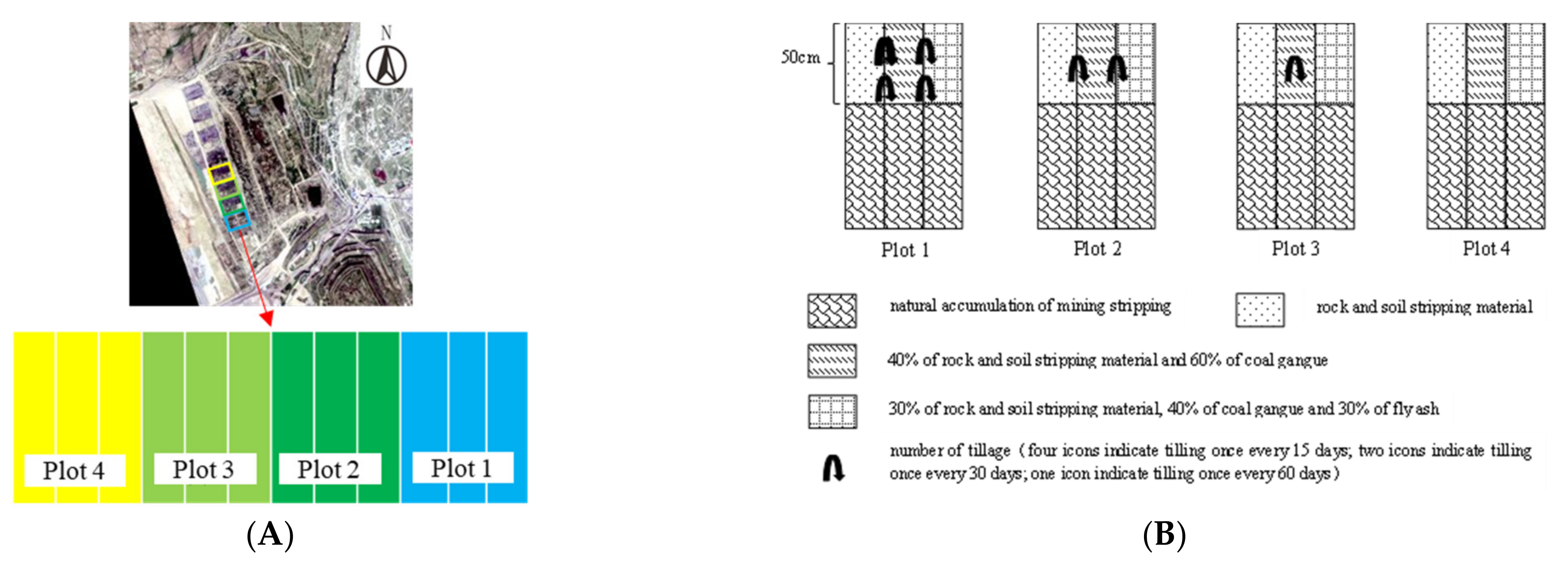
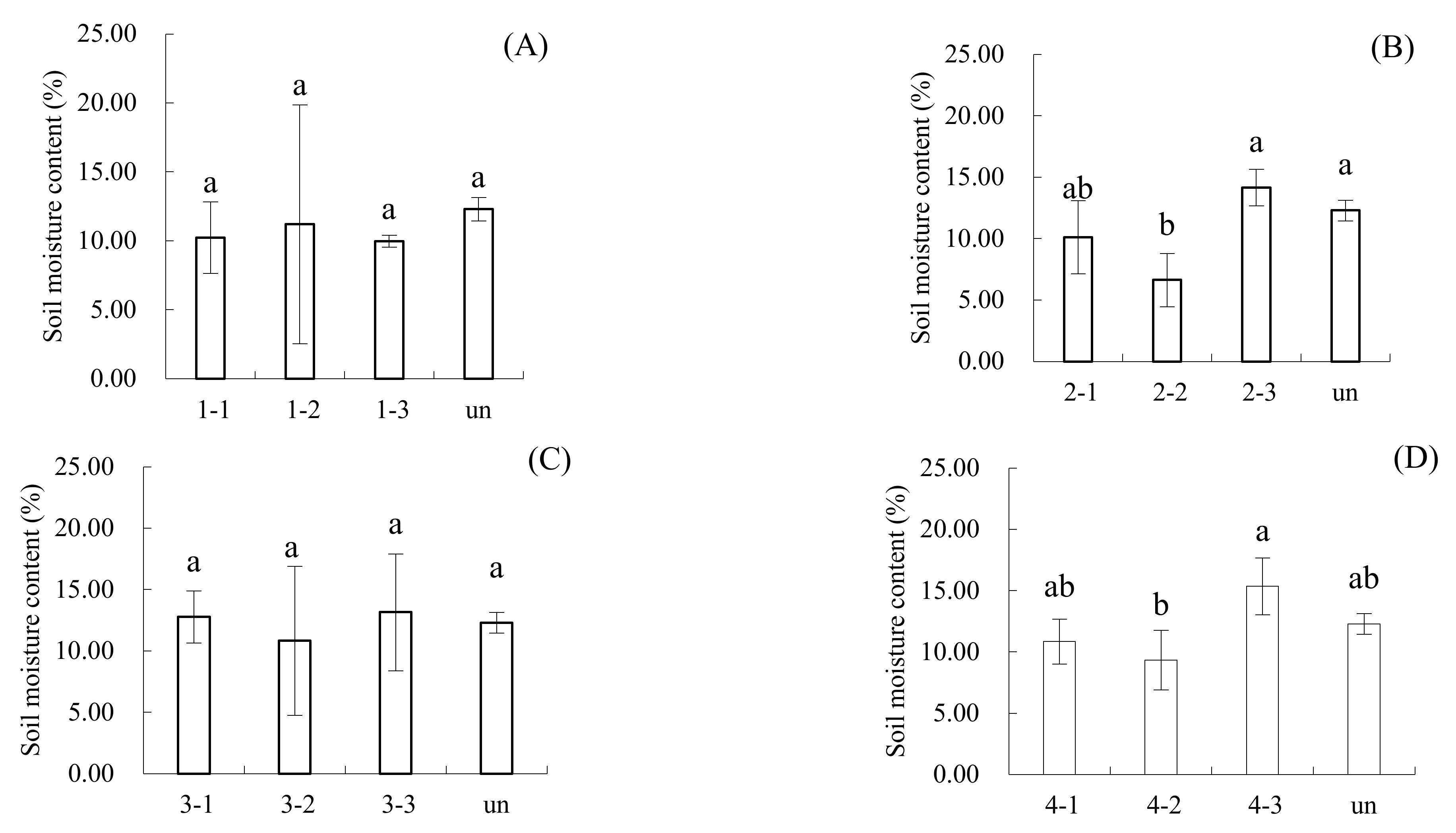


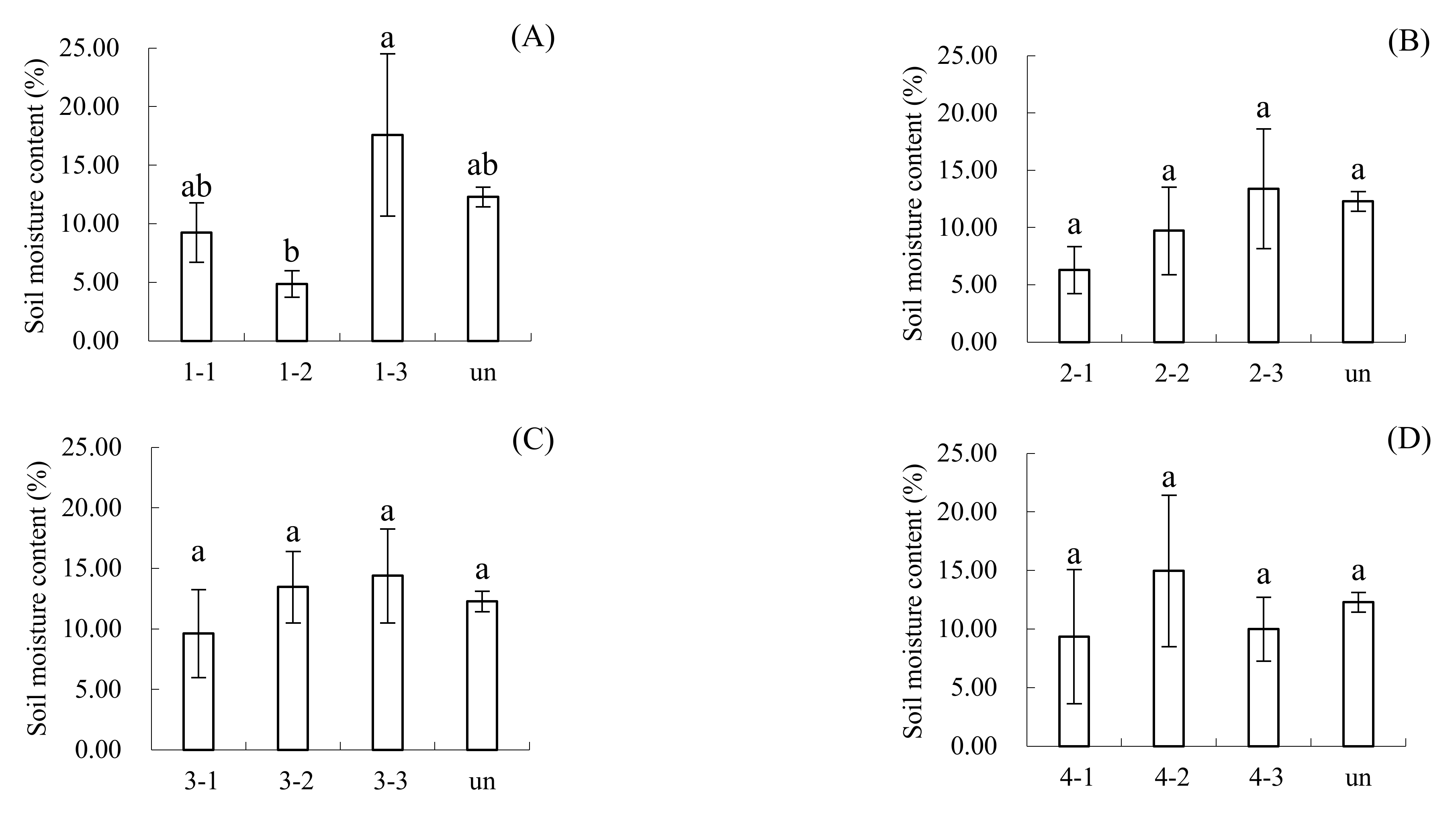
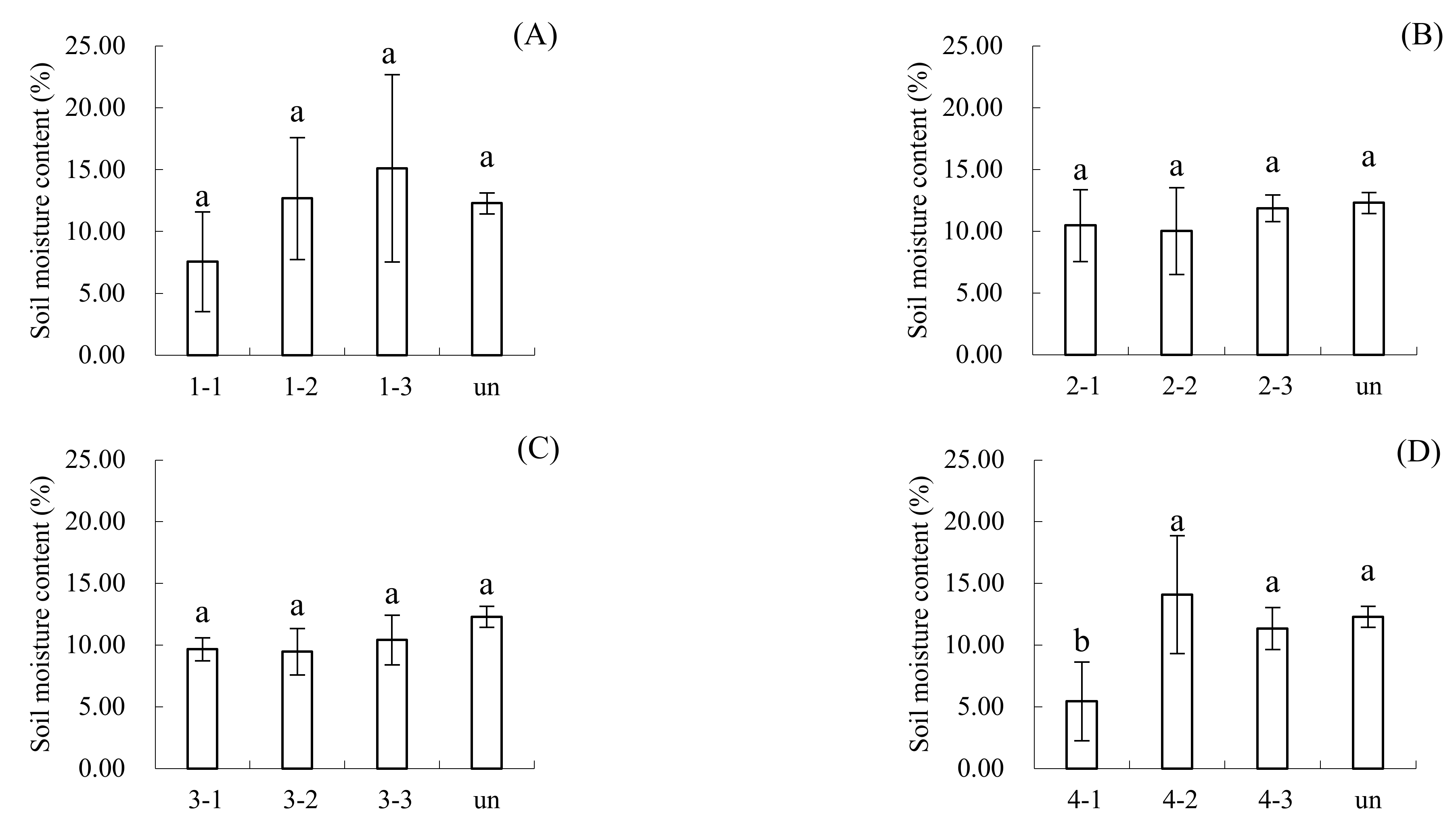
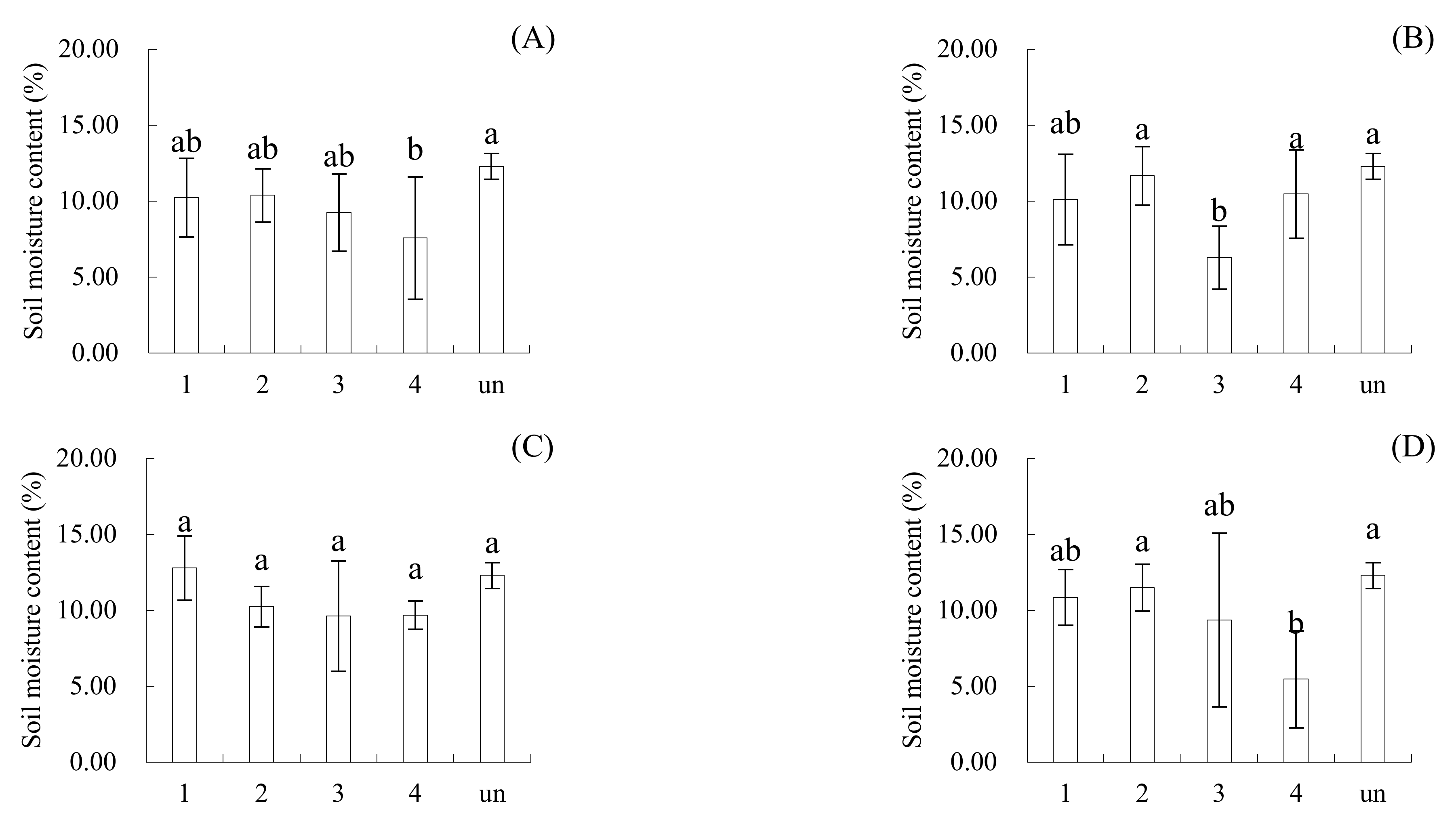



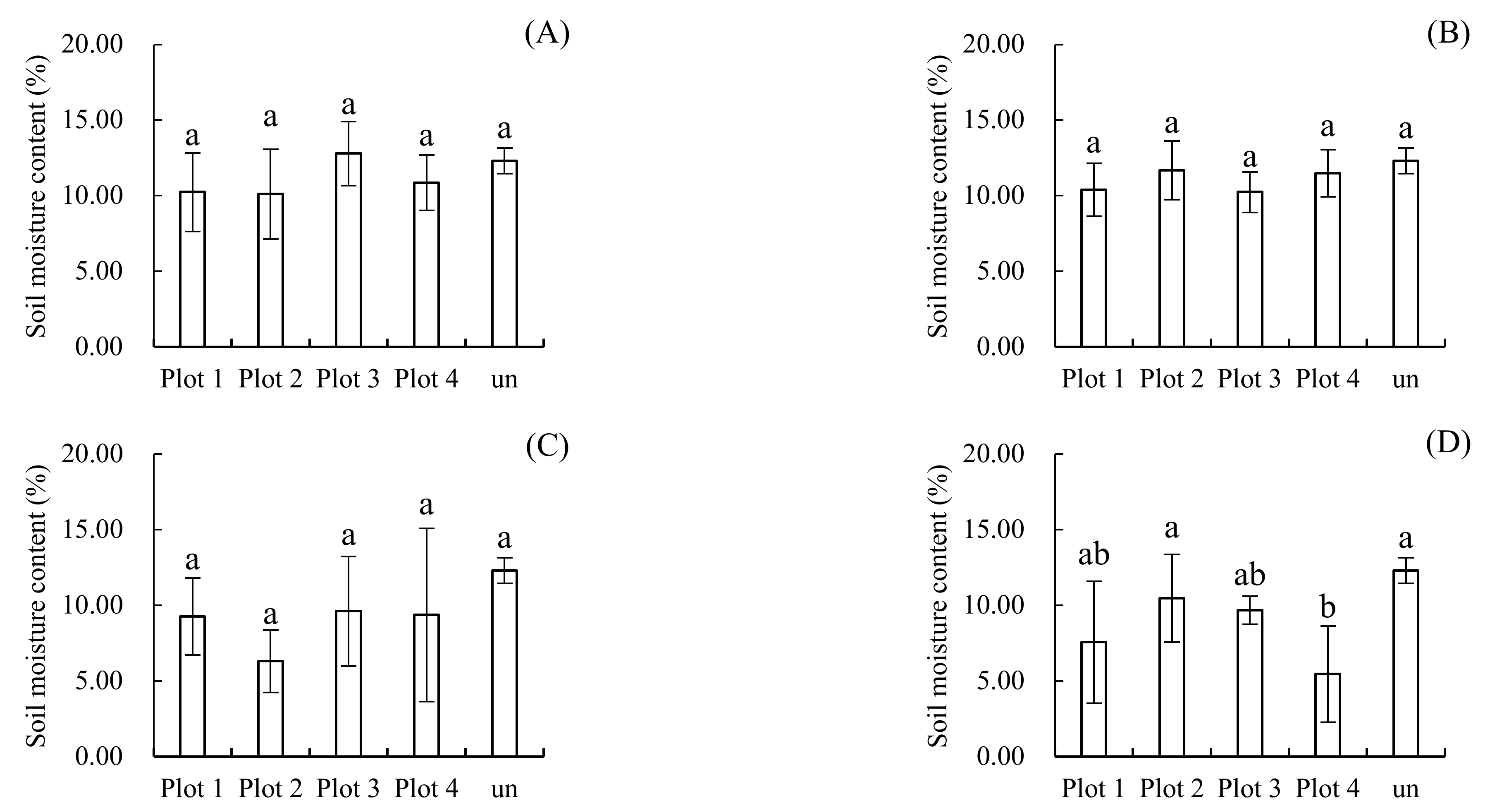
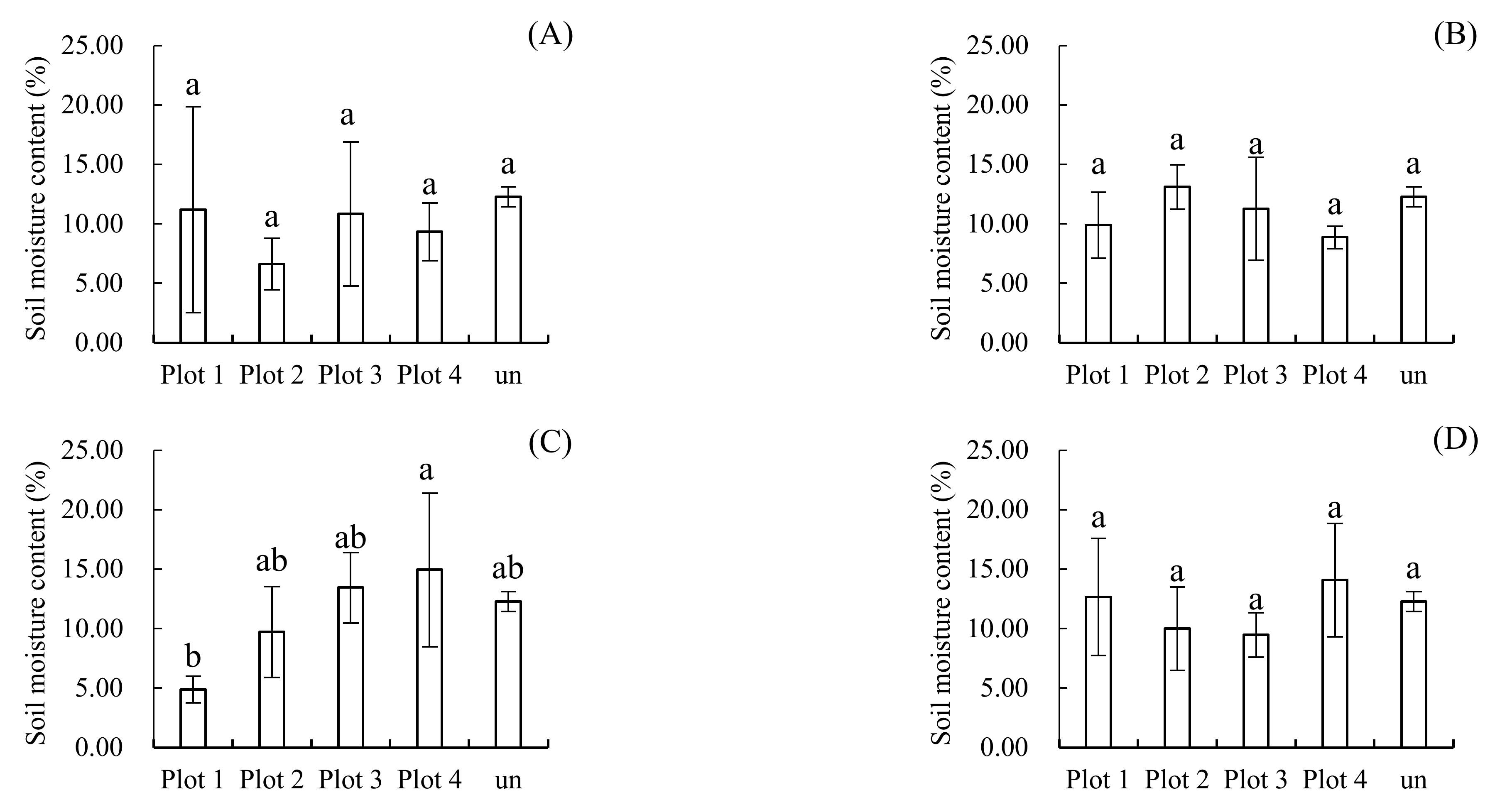
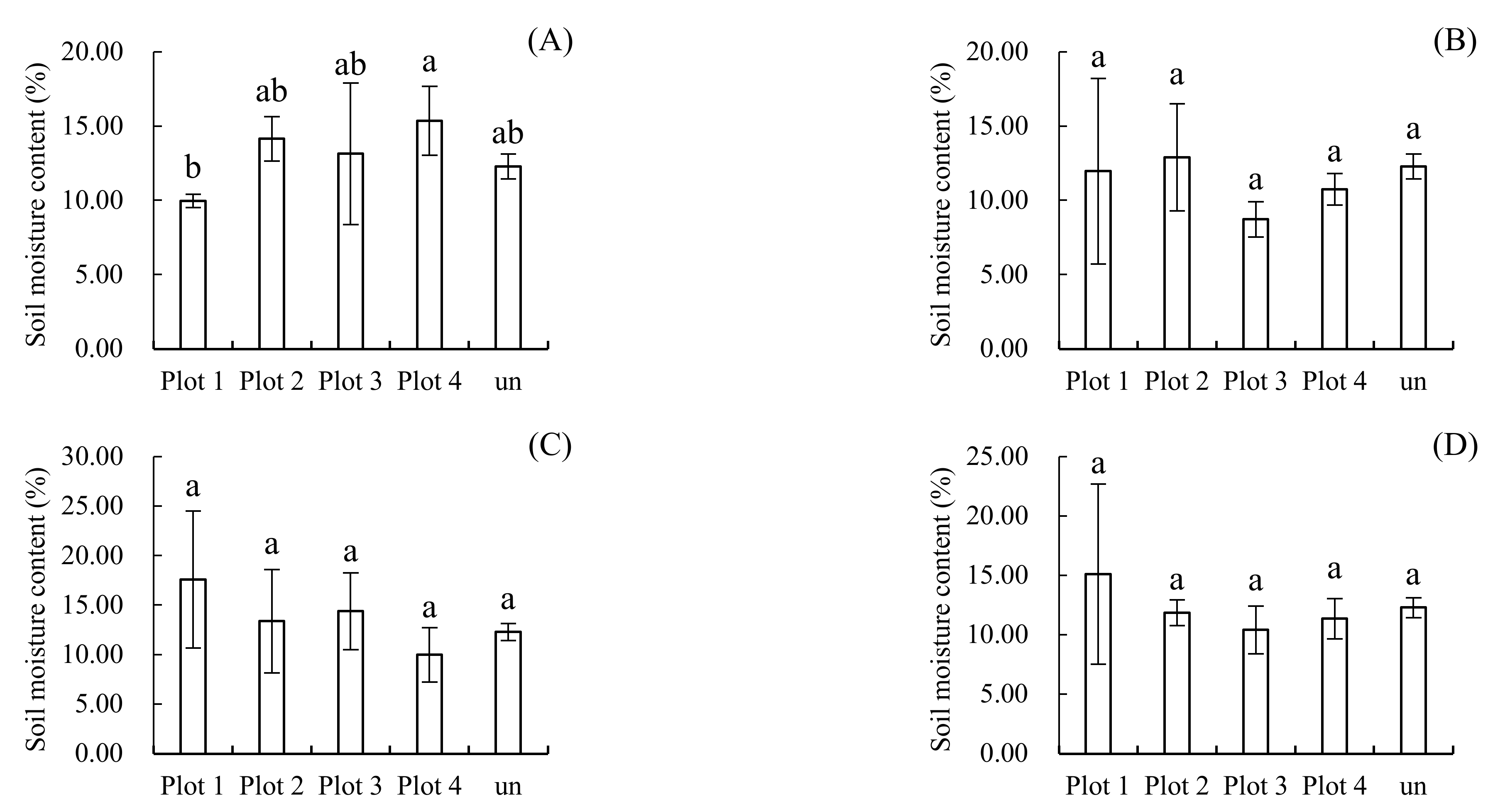
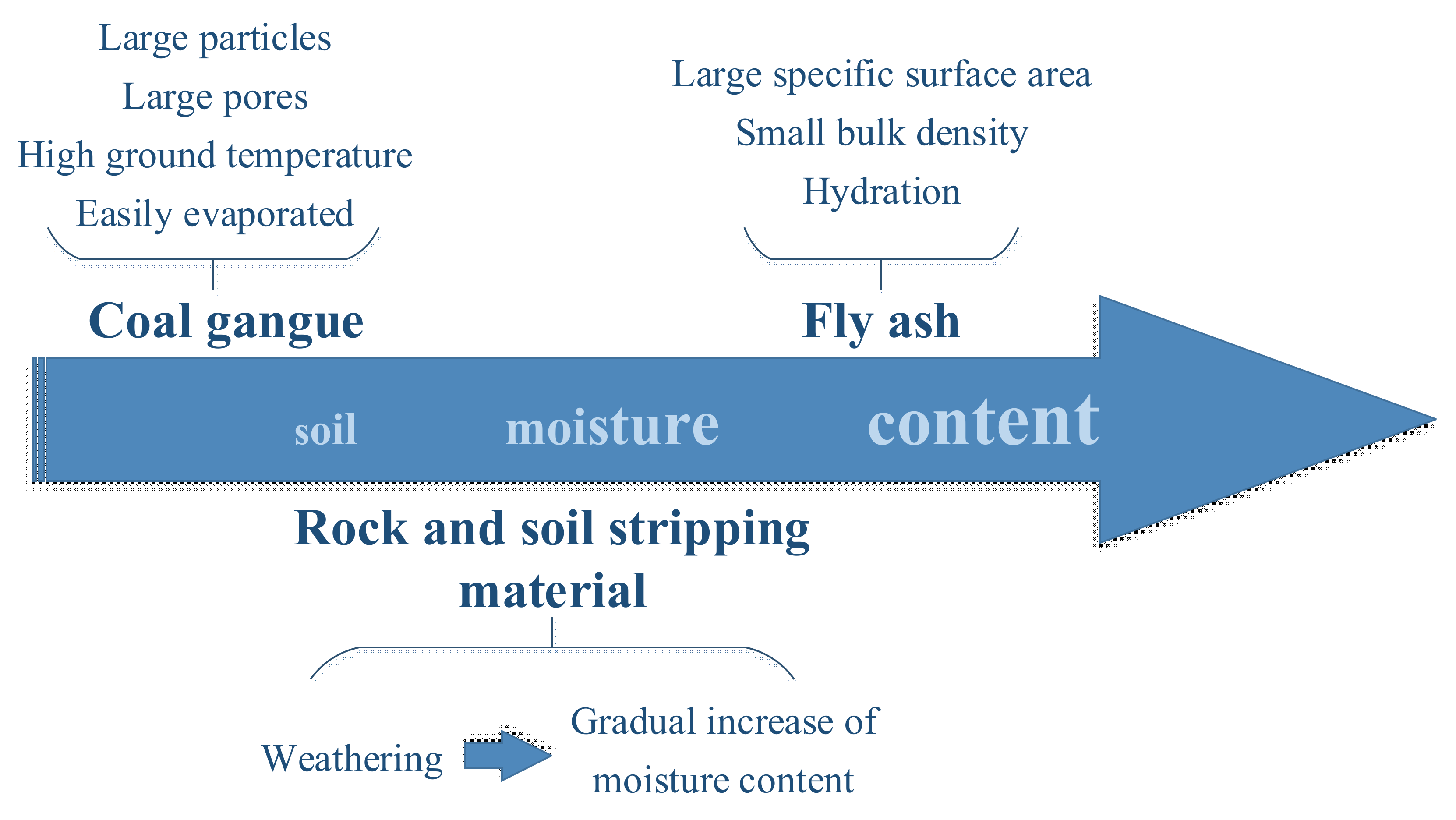
| Materials | Organic Matter (g·kg−1) | Total Nitrogen (g·kg−1) | Available Phosphorus (mg·kg−1) | Available Potassium (mg·kg−1) | Texture/ Particle Size |
|---|---|---|---|---|---|
| Topsoil | 35.4 ± 7.4 | 2.0 ± 0.5 | 5.30 ± 2.17 | 133.00 ± 54.30 | Sandy loam |
| Coal gangue | 43.9 ± 34.0 | 0.7 ± 0.4 | 2.63 ± 1.01 | 145.83 ± 92.83 | 2~5 cm |
| Fly ash | - | - | - | - | - |
| Rock and soil stripping material | 18.8 ± 5.1 | 0.9 ± 0.3 | 1.83 ± 0.86 | 50.97 ± 15.43 | Sandy clay loam |
| Soil Moisture Content (%) | Rocky Soil Stripping | Rocky Soil Stripping: Coal Gangue = 2:3 | Rocky Soil Stripping: Coal Gangue: Fly Ash = 3:4:3 | Unreclaimed Land |
|---|---|---|---|---|
| Tilling once in 15 days | 7.57 ± 4.03 ab | 12.68 ± 4.92 a | 15.11 ± 7.58 a | 12.29 |
| Tilling once in 30 days | 10.47 ± 2.91 a | 10.02 ± 3.52 a | 11.86 ± 1.08 a | 12.29 |
| Tilling once in 60 days | 9.67 ± 0.93 ab | 9.47 ± 1.87 a | 10.43 ± 2.01 a | 12.29 |
| Planting Medicago sativa L. in the same year after tillage treatment | 5.46 ± 3.19 b | 14.09 ± 4.78 a | 11.35 ± 1.69 a | 12.29 |
| Unreclaimed land | 12.29 ± 0.85 a | 12.29 ± 0.85 a | 12.29 ± 0.85 a | 12.29 |
| Average value | 9.09 | 11.71 | 12.21 | 12.29 |
Publisher’s Note: MDPI stays neutral with regard to jurisdictional claims in published maps and institutional affiliations. |
© 2022 by the authors. Licensee MDPI, Basel, Switzerland. This article is an open access article distributed under the terms and conditions of the Creative Commons Attribution (CC BY) license (https://creativecommons.org/licenses/by/4.0/).
Share and Cite
Wang, L.; Li, Y.; Zhang, J.; Qian, M.; Cao, Y. Analysis on the Difference of Reconstructed Soil Moisture Content in a Grassland Open-Pit Mining Area of China. Agronomy 2022, 12, 1061. https://doi.org/10.3390/agronomy12051061
Wang L, Li Y, Zhang J, Qian M, Cao Y. Analysis on the Difference of Reconstructed Soil Moisture Content in a Grassland Open-Pit Mining Area of China. Agronomy. 2022; 12(5):1061. https://doi.org/10.3390/agronomy12051061
Chicago/Turabian StyleWang, Lingling, Yange Li, Jianjun Zhang, Mingjie Qian, and Yingui Cao. 2022. "Analysis on the Difference of Reconstructed Soil Moisture Content in a Grassland Open-Pit Mining Area of China" Agronomy 12, no. 5: 1061. https://doi.org/10.3390/agronomy12051061
APA StyleWang, L., Li, Y., Zhang, J., Qian, M., & Cao, Y. (2022). Analysis on the Difference of Reconstructed Soil Moisture Content in a Grassland Open-Pit Mining Area of China. Agronomy, 12(5), 1061. https://doi.org/10.3390/agronomy12051061






